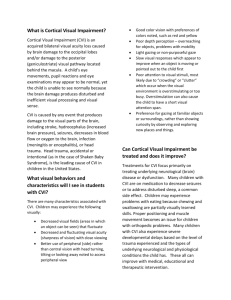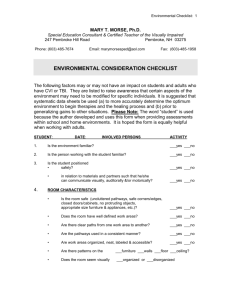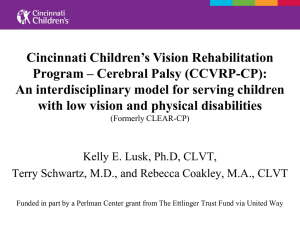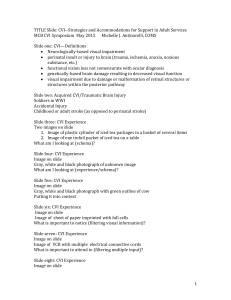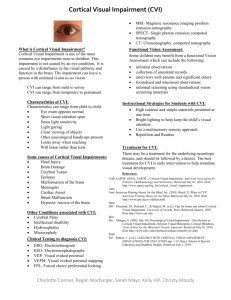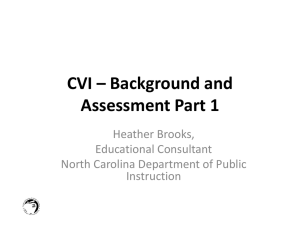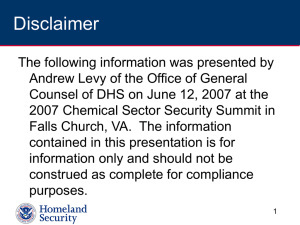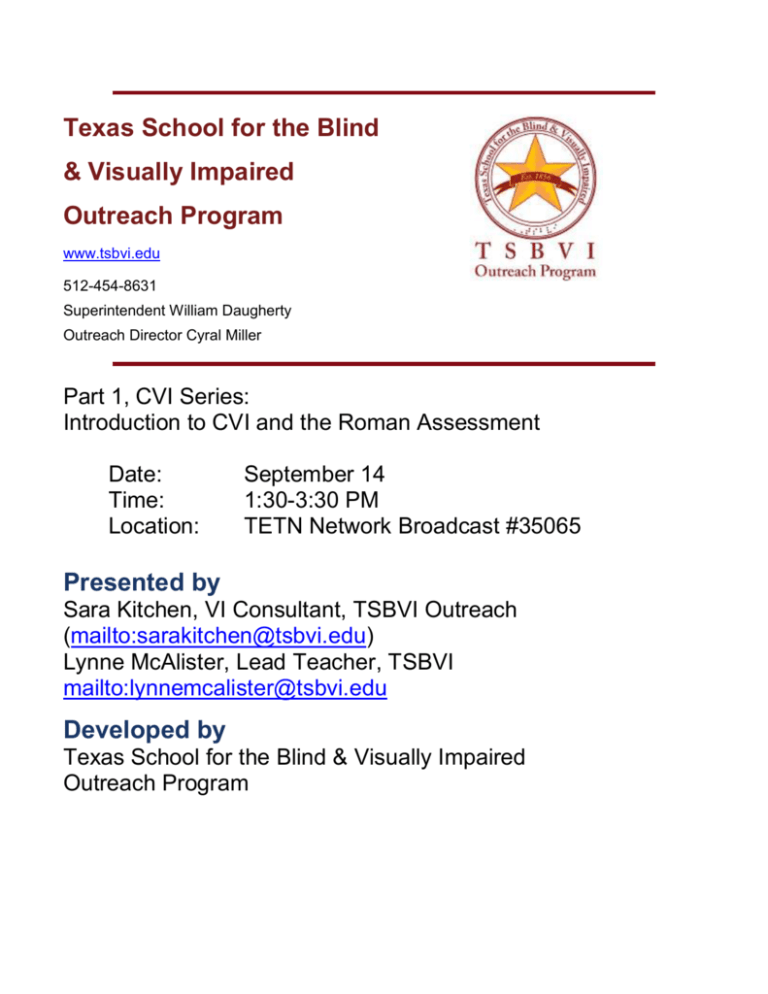
Texas School for the Blind
& Visually Impaired
Outreach Program
www.tsbvi.edu
512-454-8631
Superintendent William Daugherty
Outreach Director Cyral Miller
Part 1, CVI Series:
Introduction to CVI and the Roman Assessment
Date:
Time:
Location:
September 14
1:30-3:30 PM
TETN Network Broadcast #35065
Presented by
Sara Kitchen, VI Consultant, TSBVI Outreach
(mailto:sarakitchen@tsbvi.edu)
Lynne McAlister, Lead Teacher, TSBVI
mailto:lynnemcalister@tsbvi.edu
Developed by
Texas School for the Blind & Visually Impaired
Outreach Program
TSBVI TETN # 35065 – Part 1, CVI Series – Kitchen & McAlister, 09/2009
1
CORTICAL VISUAL IMPAIRMENT
WHAT WE LEARNED AT THE CVI CONFERENCE
By Carolyn Mason and Chrissy Cowan
Modified by Jim Durkel (JimDurkel@tsbvi.edu)
And then modified more by Sara Kitchen (sarakitchen@tsbvi.edu) &
Lynne McAlister (lynnemcalister@tsbvi.edu)
Definition and Incidence
Definition of cortical visual impairment
New field of research
Fastest growing visual impairment
Diagnosis
The Problem w/ Medical Diagnosis
Eye report frequently doesn’t say “CVI”
Best information may come from neurological
Test like MRI is not necessarily useful in diagnosing CVI
Look for “red flags”
TSBVI TETN # 35065 – Part 1, CVI Series – Kitchen & McAlister, 09/2009
2
Red Flags
Asphyxia-damage depends on severity & duration. Some causes:
placenta previa, prolapsed cord, delivery complications.
Hypoxic Ischemic Encephalopathy-too little oxygen (hypoxia), too
little blood flow (ischemia), irritation of the brain (encephalopathy).
Results from asphyxia. Seizures common.
Cerebral Vascular Accident-(stroke) blood capillaries in the brain
rupture, damage depends on extent of bleed, more common in full
term male infants, mostly affects left side of brain, seizures
common.
Intraventricular Hemorrhage-occurs in premature infants w/in 1st 48
hours. Severity grades I-IV.
Periventricular Leukomalacia (PVL)-something, such as trauma,
occurs and oxygen does not get to the distant areas of brain.
These die and become filled w/ fluid (sometimes called cysts in the
brain. Can cause CP, developmental delays.
Infection-viral and bacterial (TORCH)=toxoplasmosis, rubella
cytomegalovirus, herpes/HIV. Also meningitis.
TSBVI TETN # 35065 – Part 1, CVI Series – Kitchen & McAlister, 09/2009
3
The Brain from Top to Bottom:
http://thebrain.mcgill.ca/
Figure 1 Image of the brain including the functional subdivisions of the
visual cortex, cerebellum, inferior temporal cortex (ITC), temporal lobe,
lateral geniculate nucleus (LGN), frontal lobe, parietal lobe, and
occipital lobe.
TSBVI TETN # 35065 – Part 1, CVI Series – Kitchen & McAlister, 09/2009
4
Current Trends in Neuroscience
Hardwired: Outdated theories stated that the brain was static and
could not be healed once injured.
Neuroplasticity: Current beliefs include the brain’s ability to
organize and reorganize itself.
Paula Bach Y Rita discovered that sensory information could be
received through different channels (in the early 1970s!):
http://www.pbs.org/kcet/wiredscience/video/286mixed_feelings.html
TSBVI TETN # 35065 – Part 1, CVI Series – Kitchen & McAlister, 09/2009
5
Unique Characteristics of CVI
Color: strong reaction/preferential response to a particular color,
typically red or yellow. Color receptors are diffused through brain &
almost all children have some color vision. Need their favorite color as
a visual anchor.
Lily likes red better than yellow.
Movement: Stimulates the “aware” system, gets the visual system
activated. Movement w/out sound is generally easier to visually
process.
Movement plus reflective qualities provide an invasive, difficult to ignore
effect on the visual system.
Child may exhibit better than expected navigational skills.
Latency: delayed response to presentation of object. Can vary
according to time of day, state of alertness, degree of stress, and
neurological stability. Decrease in latency equals increase in visual
behavior.
How long does it take to look?
Visual Field Preferences: definition of visual field defect: a blind spot
(scotoma) or blind area within the normal field of one or both eyes. In
most cases the blind spots or areas are persistent, but in some
instances they may be temporary and shifting, as in the scotomas of
migraine headache.
(http://www.britannica.com/EBchecked/topic/630842/visual-field-defect)
It just appeared out of nowhere.
Mixed field preferences: May use one eye for a field preference, and
the other for verification.
Let me take a second look.
TSBVI TETN # 35065 – Part 1, CVI Series – Kitchen & McAlister, 09/2009
6
Complexity: most interfering of all characteristics.
Target/object-some objects are too complex, and there is no place
for child to anchor his vision and so vision shuts down: faces are
very complex.
Array-what’s behind the object can cause problems even with
preferred objects. This is responsible for the misconception that
vision is variable. Actually, vision is constant, but background
interferes with vision functioning.
Sensory environment-unable to process with more than one sense
at a time; will defer to auditory over vision. Be careful where you
place auditory stimuli. Limit talking while doing vision work.
Abnormal Reaction to Light-Photophobia/Light Gazing/NonPurposeful Gaze-prominent in early stages.
Distance Viewing-As object gets farther away, complexity increases.
Makes child appear nearsighted.
Visual Reflexive Responses-absent, intermittent, or delayed blink
reflex. Blink to threat; blink when you touch the bridge of the nose.
Visual Novelty-strong response to familiar objects. Appear to ignore
novel items.
Visual Motor-look and touch may happen as separate events.
TSBVI TETN # 35065 – Part 1, CVI Series – Kitchen & McAlister, 09/2009
7
Resolution of Characteristics
Best chance for resolution is within first 3 years
Characteristics will not resolve without structured intervention
o Phase I: Building visual behavior
o Phase II: Integrating vision with function
o Phase III: Resolution of all CVI characteristics
Order of Resolution
Early resolution: light gazing, and visual reflexive response of blink
Mid-Resolution: color, latency, visual novelty, visual reflexive
response of blink to threat, and movement
Later Resolution: visual fields, visual motor, complexity, and
distance vision
TSBVI TETN # 35065 – Part 1, CVI Series – Kitchen & McAlister, 09/2009
8
ASSESSMENT:
Assessment Framework
Interview
Observation
Direct evaluation of student
Parent Interview/Teacher Interview
Information on medical background
Eye report
What does child like to look at
What are your concerns
Child’s favorite color
When is child most visually alert
Does child look directly into faces
Does child notice things that move more than things that are stable
Does child seem to look “through” rather than at objects
TSBVI TETN # 35065 – Part 1, CVI Series – Kitchen & McAlister, 09/2009
9
Observation of Vision
In living and learning environments
Quiet and noisy times
Near and distance
Familiar and unfamiliar objects
Cluttered and simple backgrounds
Interest in objects of specific color (color preference)
Movement
Light gazing
Preferential viewing
Direct Evaluation
Evaluate range of visual functioning
Evaluate presence and degree of individual CVI characteristics
May need several sessions to test
TSBVI TETN # 35065 – Part 1, CVI Series – Kitchen & McAlister, 09/2009
10
INTERVENTION:
Possible Environmental Considerations at Level I
Precaution about “Vision Stimulation”
For the child who is in Phase I of building resolution, the child
visually attends:
o to familiar objects (usually one color)
o when there are no sound distracters
o when there are no visual distracters
o when room light is low
Possible Environmental Considerations at Level II
For the child who is in Phase II of building resolution, the child can
attend:
o to objects that share features of color or pattern with the
“familiar” objects
o when familiar or low intensity auditory inputs compete
o on increased pattern/object beyond 3-4 feet
o to different lighting situations (not overly attentive to lights)
Goal of Intervention:
“For Children with CVI, it is important to determine where they are
on the continuum of possible impact of CVI, to identify in this way what
they are able to look at or are interested in looking at, and to give them
as many opportunities to look as possible by integrating motivating
activities and materials into their daily lives. The goal is to facilitate
looking.” (Page 114, Roman-Lantzy, Cortical Visual Impairment: An
Approach to Assessment and Intervention.
TSBVI TETN # 35065 – Part 1, CVI Series – Kitchen & McAlister, 09/2009
11
Case Study: Cassie
9 years old
CVI secondary to anoxia from surgery during infancy
Auditory processing disorder
Deafblind label
Developmental delays
Speech Impaired
Extremely social
Uses object calendar
CVI Resolution Chart 101
Review Range of Characteristics.
Number the boxes for next activity
Interview
See handouts:
o CVI Interview questions for parents/caregivers (Cassie)
o Appendix 4.A Answer Guide to CVI Parent Interview
Questions
Write notes on CVI Resolution Chart
TSBVI TETN # 35065 – Part 1, CVI Series – Kitchen & McAlister, 09/2009
12
Observation
Watch Movie
Make notes on CVI Resolution Chart in a new color
Direct Assessment
Watch video of direct assessment.
Record results on CVI Resolution Chart.
Refine Results
Record results on “Essential Forms” (Rating II) on Number Line
See Appendix 5.A CVI Scoring Guide for help with filling out Rating
I.
Record numbers and find CVI Range
Intervention
Page 132: Tips for providing interventions by phase IN THE BOOK
Page 138, table 6.1 Sample activities.
Bulleted list for Cassie (see handout)
Report as addendum to functional vision assessment
TSBVI TETN # 35065 – Part 1, CVI Series – Kitchen & McAlister, 09/2009
13
Resources:
Roman-Lantzy, C. (2007) Cortical Visual Impairment: An Approach to
Assessment and Intervention American Foundation for the Blind
Press (www.afb.org/store)
American Printing House for the Bllind (APH) CVI Website:
http://www.aph.org/cvi/index.html
References
Giaschi, D., Jan, J. E., Bjornson, B., Young, S. A., Tata M., Lyons C. J.,
et al. (2003). Conscious visual abilities in a patient with early bilateral
occipital damage. Developmental Medicine and Child Neurology, 45,
772-781.
Good, W. V., Jan, J. E., Burden, S. K., Skoczenski, A., & Candy, R.
(2001). Recent advances in cortical visual impairment.
Developmental Medicine and Child Neurology, 43, 50-60.
Hoyt, C. (2003). Visual function in the brain-damaged child. Eye, 17,
369-384.
Lanners, J., Piccioni, A., Fea, F., & Goergen, E. (1999). Early
intervention for children with cerebral visual impairment: Preliminary
results. Journal of Intellectual Disability Research, 43(1), 1-12.
Maitre, S., & Haerich, P. (2005). Visual attention to movement and color
in children with cortical visual impairment. Journal of Visual
Impairment & Blindness, July, 2005.
Milner, A. (1997). Vision without knowledge. Philosophical Transactions:
Biological Sciences, 352 (1358).
TSBVI TETN # 35065 – Part 1, CVI Series – Kitchen & McAlister, 09/2009
14
CVI Resolution Chart
From Cortical Visual Impairment: An Approach to Assessment and Intervention, by Chirsitine
Roman-Lantzy, copyright © 2007, AFB Press, New York. All rights reserved. This page may be
reproduced for educational use only.
Date:
Student’s Name:
Evaluator:
Use the following chart to help develop areas of needs for development of IEP goals and
objectives.
Phase I:
Phase II:
Phase III:
Bulding Visual
Behavior
Integrating Vision with
Function
Resolution of CVI
Characteristics
Level I
Environmental
Considerations
Level II Environmental
Considerations
Level II
Environmental
Considerations
CVI
Range 1-2 (0) Range 3-4
Characteristics
(.25)
Color
Preferences
Objects
viewed are
generally a
single color
Has “favorite”
color
Range 5-6
(.50)
Range 7-8
(.75)
Range 9-10
(1)
Objects may
have two to
three favored
colors
More colors,
familiar
patterns
regarded
No color or
pattern
preferences
TSBVI TETN # 35065 – Part 1, CVI Series – Kitchen & McAlister, 09/2009
15
Phase I:
Phase II:
Phase III:
Bulding Visual
Behavior
Integrating Vision with
Function
Resolution of CVI
Characteristics
Level I
Environmental
Considerations
Level II Environmental
Considerations
Level II
Environmental
Considerations
CVI
Range 1-2 (0) Range 3-4
Characteristics
(.25)
Range 5-6
(.50)
Range 7-8
(.75)
Range 9-10
(1)
Need for
movement
Objects
viewed
generally have
movement or
reflective
properties
More
Consistent
localization,
brief fixations
on movement
and reflective
materials
Movement
continues to
be an
important
factor to
initiate visual
attention
Movement
not required
for attention
at near
Typical
responses to
moving targets
Visual latency
Prolonged
Periods of
visual latency
Latency
slightly
decreases
after periods
of consistent
viewing
Latency
Latency rarely Latency
present only
present
resolved
when student
is tired,
(continued)
stressed or
overstimulated
TSBVI TETN # 35065 – Part 1, CVI Series – Kitchen & McAlister, 09/2009
16
Phase I:
Phase II:
Phase III:
Bulding Visual
Behavior
Integrating Vision with
Function
Resolution of CVI
Characteristics
Level I
Environmental
Considerations
Level II Environmental
Considerations
Level II
Environmental
Considerations
CVI
Range 1-2 (0) Range 3-4
Characteristics
(.25)
Range 5-6
(.50)
Range 7-8
(.75)
Visual field
preferences
Field
preferences
decreasing
with familiar
inputs
May alternate Visual fields
use of right
unrestricted
and left fields
Distinct field
dependency
Shows visual
field
preferences
TSBVI TETN # 35065 – Part 1, CVI Series – Kitchen & McAlister, 09/2009
Range 9-10
(1)
17
Phase I:
Phase II:
Phase III:
Bulding Visual
Behavior
Integrating Vision with
Function
Resolution of CVI
Characteristics
Level I
Environmental
Considerations
Level II Environmental
Considerations
Level II
Environmental
Considerations
CVI
Range 1-2 (0) Range 3-4
Characteristics
(.25)
Range 5-6
(.50)
Range 7-8
(.75)
Range 9-10
(1)
Difficulties with
visual
complexity
Student
tolerates low
levels of
familiar
background
noise
Competing
auditory
stimuli
tolerated
during
periods of
viewing;
student may
now maintain
visual
attention on
musical toys
Only the most
complex visual
environments
affect visual
response
Responds
only in strictly
controlled
environments
Generally no
regard of the
human face
Visually
fixates when
environment is
controlled
Regards
familiar faces
when voice
does not
compete
Views simple
books or
symbols
TSBVI TETN # 35065 – Part 1, CVI Series – Kitchen & McAlister, 09/2009
Smiles at
re/regards
familiar and
Views books
or other twodimensional
materials
Typical
visual/social
responses
18
Phase I:
Phase II:
Phase III:
Bulding Visual
Behavior
Integrating Vision with
Function
Resolution of CVI
Characteristics
Level I
Environmental
Considerations
Level II Environmental
Considerations
Level II
Environmental
Considerations
CVI
Range 1-2 (0) Range 3-4
Characteristics
(.25)
Light-gazing
and
nonpurposeful
gase
May localize
briefly, but no
prolonged
fixations on
objects or
faces
Range 5-6
(.50)
Range 7-8
(.75)
Range 9-10
(1)
Less attracted Light is no
to lights; can
longer a
be redirected distracter
to other
targets
Overly
attentive to
lights or
perhaps
ceiling fans
TSBVI TETN # 35065 – Part 1, CVI Series – Kitchen & McAlister, 09/2009
19
Phase I:
Phase II:
Phase III:
Bulding Visual
Behavior
Integrating Vision with
Function
Resolution of CVI
Characteristics
Level I
Environmental
Considerations
Level II Environmental
Considerations
Level II
Environmental
Considerations
CVI
Range 1-2 (0) Range 3-4
Characteristics
(.25)
Range 5-6
(.50)
Range 7-8
(.75)
Range 9-10
(1)
Difficulty with
distance
viewing
Visual
attention
extends
beyond near
space, up to 4
to 6 feet
Visual
attention
extends to 10
feet with
targets that
produce
movement
Visual
attention
extends
beyond 20
feet
Visually
attends in
near space
only
Occasional
visual
attention to
familiar,
moving, or
large targets
at 2 to 3 feet
TSBVI TETN # 35065 – Part 1, CVI Series – Kitchen & McAlister, 09/2009
Demonstrates
memory of
visual events
20
Phase I:
Phase II:
Phase III:
Bulding Visual
Behavior
Integrating Vision with
Function
Resolution of CVI
Characteristics
Level I
Environmental
Considerations
Level II Environmental
Considerations
Level II
Environmental
Considerations
CVI
Range 1-2 (0) Range 3-4
Characteristics
(.25)
Range 5-6
(.50)
Range 7-8
(.75)
Range 9-10
(1)
Atypical visual
reflexes
Blink response
to touch
consistently
present
Visual threat
response
consistently
present (both
reflexes near
90 present
resolved)
Visual reflexes
always
present;
resolved
No blink in
response to
touch and/or
visual threat
Blinks in
response to
touch, but
response may
be latent
Visual threat
response
intermittently
present
TSBVI TETN # 35065 – Part 1, CVI Series – Kitchen & McAlister, 09/2009
21
Phase I:
Phase II:
Phase III:
Bulding Visual
Behavior
Integrating Vision with
Function
Resolution of CVI
Characteristics
Level I
Environmental
Considerations
Level II Environmental
Considerations
Level II
Environmental
Considerations
CVI
Range 1-2 (0) Range 3-4
Characteristics
(.25)
Range 5-6
(.50)
Range 7-8
(.75)
Range 9-10
(1)
Difficulty with
visual novelty
Use of
“known”
objects to
initiate looking
sequence
Selection of
objects less
restricted,
one to two
sessions of
“warm up”
time required
Selection of
objects not
restricted
Only favorite
or known
objects elicit
visual
attention
May tolerate
novel objects
if the novel
objects share
characteristics
of familiar
objects
TSBVI TETN # 35065 – Part 1, CVI Series – Kitchen & McAlister, 09/2009
22
Phase I:
Phase II:
Phase III:
Bulding Visual
Behavior
Integrating Vision with
Function
Resolution of CVI
Characteristics
Level I
Environmental
Considerations
Level II Environmental
Considerations
Level II
Environmental
Considerations
CVI
Range 1-2 (0) Range 3-4
Characteristics
(.25)
Range 5-6
(.50)
Range 7-8
(.75)
Range 9-10
(1)
Absence of
visually guided
reach
Visually
guided reach
used with
familiar
objects or
“favorite” color
Look and
touch occur in
rapid
sequence, but
not always
together
Look and
touch occur
together
consistently
Look and
touch occur as
separate
functions
Look and
touch occur
with smaller
objects that
are familiar,
lighted, or
reflective
Look and
touch occur
with large
and/or moving Look and
objects
touch are still
separate
TSBVI TETN # 35065 – Part 1, CVI Series – Kitchen & McAlister, 09/2009
23
Key:
Draw an X though boxes that represent resolved visual behaviors
Use highlighter to outline boxes describing current visual functioning
Draw an O in boxes describing visual skills that may never resolve because of coexisting ocular
conditions
From Cortical Visual Impairment: An Approach to Assessment and Intervention, by Chirsitine
Roman-Lantzy, copyright © 2007, AFB Press, New York. All rights reserved. This page may be
reproduced for educational use only.
TSBVI TETN # 35065 – Part 1, CVI Series – Kitchen & McAlister, 09/2009
24
TSBVI TETN # 35065 – Part 1, CVI Series – Kitchen & McAlister, 09/2009
25
Texas School for the Blind & Visually Impaired
Outreach Program
www.tsbvi.edu
QuickTi me™ and a
decompressor
are needed to see thi s pi ctur e.
Figure 2 Office of Special Education Logo
"This project is supported by the U.S. Department of Education, Office
of Special Education Programs (OSEP). Opinions expressed herein are
those of the authors and do not necessarily represent the position of the
U.S. Department of Education."
TSBVI TETN # 35065 – Part 1, CVI Series – Kitchen & McAlister, 09/2009
26


